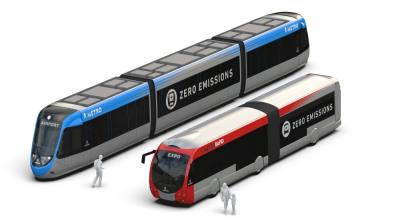On Monday, March 9, Capital Metro staff will bring new details of the plan to Austin City Council with a significant update—light rail connecting areas of town from North Lamar Boulevard to South Congress Avenue and the Austin-Bergstrom International Airport.
According to the plans, one light rail line—which Capital Metro is calling the Orange Line—would run between the North Lamar Transit Center and the intersection of South Congress and Stassney Lane, passing through The Drag, downtown and the Colorado River along the way.
The other light rail line—called the Blue Line—would run parallel with the Orange Line between the North Lamar Transit Center and Republic Square downtown, allowing trains to run every five minutes in that section of the city rather than every 10 minutes in other areas. The two lines would split off from a central point downtown, with the Orange Line continuing along South Congress and the Blue Line following Riverside Drive to the airport.
A second phase of work would extend the Orange Line light rail to Tech Ridge and Slaughter Lane. Project Connect program manager Dave Couch said he expects the light rail would be extended some time in 2040s, and in the interim, MetroRapid buses would run in those areas.
At the nexus of those two light rail lines downtown, an underground tunnel would take the trains out of street traffic. According Couch, the 1.6-mile tunnel would connect the Orange and the Blue lines, running along Guadalupe and Trinity streets with a connection between the two on Fourth Street.
Couch said the southern end of that underground tunnel has not yet been determined. It could end at the Colorado River with an aboveground bridge taking trains to South Austin. Or, Couch said, the tunnel could go under the river and go through a stop at Auditorium Shores before trains come back up to street level on South Congress.
“Some people think [the tunnel] is just a benefit for people that are in the center part of the city. It's really a benefit for everybody, regardless of what portion of the system that you're getting on, to be able to go ahead and get in and out of downtown,” Couch said.
In the fall, Capital Metro officials released estimated costs for the transit plan, putting the total cost between $4.7 billion to $9.8 billion but $2.8 billion to $5.9 billion for local funding once federal funding took a piece out of some of those costs.
Couch did not give updated cost figures, but he said the range of updated cost figures will narrow. Previously, Capital Metro officials had considered bus-rapid transit for the Blue and Orange lines. Without bus as an option, the floor of the range will likely be raised with the ceiling remaining the same, Couch said.
The March 9 meeting will be the first significant step forward in the process since January, when City Council members weighed in. At that Jan. 14 meeting, Capital Metro staff told council a transit system focused on buses would be obsolete by 2040 due to the bus system’s limited ability to add cars to keep up with population growth.
The plans Capital Metro will present March 9 do include one bus-rapid transit line, called the Gold Line that will take riders in transit-only lanes from Austin Community College’s Highland campus downtown to the Austin Convention Center and Republic Square.
After the March 9 meeting with City Council, Capital Metro staff will hold a series of community meetings this spring until May 28, when the transit agency’s board is scheduled to take a vote on the recommendation. From there, the city could call an election in November asking voters to approve a transportation referendum by increasing the tax rate or seeking a tax rate election to provide a dedicated funding stream.
Jackie Nirenberg, Capital Metro’s manager of community involvement, said she hopes to give residents a better idea of how the plans could impact their pocketbooks at the community meetings.
“When people hear big numbers, they can be off-putting," she said. "They can also be difficult to understand in terms of what it means to me as an individual. We’re going to try to give them a better idea of what specifically that could mean to each and every one of them."
Other details in the Project Connect plan include:
- two new MetroRail Red Line stations at the forthcoming Austin FC soccer stadium and Broadmoor campus in North Austin
- a new commuter rail through East Austin called the Green Line
- seven new MetroRapid bus routes, with the first running in the areas of the Travis County Exposition Center and Pleasant Valley Road
- 14 new Park & Rides where residents can drive to a lot, park and catch a bus or train
- new circulators that pick up and drop off residents within their neighborhood
- additional electric buses
Editor's Note: A clarification was added to this article to note the second phase of the Orange Line would add light rail to Tech Ridge and Slaughter Lane.






